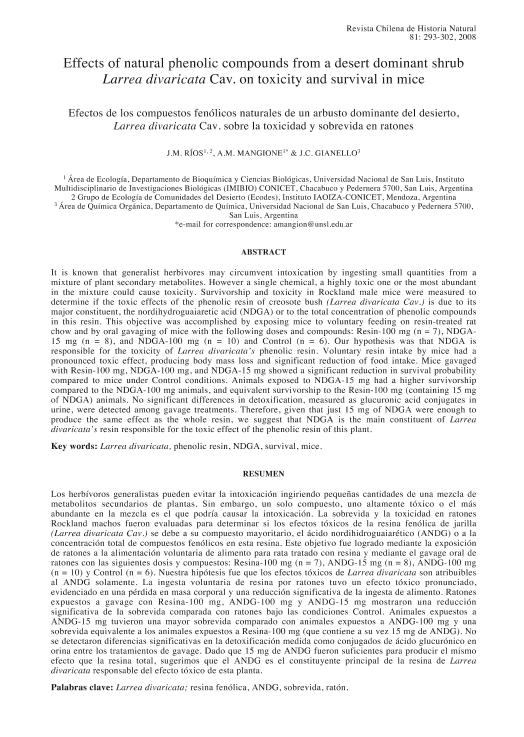Artículo
Los herbívoros generalistas pueden evitar la intoxicación ingiriendo pequeñas cantidades de una mezcla de metabolitos secundarios de plantas. Sin embargo, un solo compuesto, uno altamente tóxico o el más abundante en la mezcla es el que podría causar la intoxicación. La sobrevida y la toxicidad en ratones Rockland machos fueron evaluadas para determinar si los efectos tóxicos de la resina fenólica de jarilla (Larrea divaricata Cav.) se debe a su compuesto mayoritario, el ácido nordihidroguaiarético (ANDG) o a la concentración total de compuestos fenólicos en esta resina. Este objetivo fue logrado mediante la exposición de ratones a la alimentación voluntaria de alimento para rata tratado con resina y mediante el gavage oral de ratones con las siguientes dosis y compuestos: Resina-100 mg (n = 7), ANDG-15 mg (n = 8), ANDG-100 mg (n = 10) y Control (n = 6). Nuestra hipótesis fue que los efectos tóxicos de Larrea divaricata son atribuibles al ANDG solamente. La ingesta voluntaria de resina por ratones tuvo un efecto tóxico pronunciado, evidenciado en una pérdida en masa corporal y una reducción significativa de la ingesta de alimento. Ratones expuestos a gavage con Resina-100 mg, ANDG-100 mg y ANDG-15 mg mostraron una reducción significativa de la sobrevida comparada con ratones bajo las condiciones Control. Animales expuestos a ANDG-15 mg tuvieron una mayor sobrevida comparado con animales expuestos a ANDG-100 mg y una sobrevida equivalente a los animales expuestos a Resina-100 mg (que contiene a su vez 15 mg de ANDG). No se detectaron diferencias significativas en la detoxificación medida como conjugados de ácido glucurónico en orina entre los tratamientos de gavage. Dado que 15 mg de ANDG fueron suficientes para producir el mismo efecto que la resina total, sugerimos que el ANDG es el constituyente principal de la resina de Larrea divaricata responsable del efecto tóxico de esta planta. It is known that generalist herbivores may circumvent intoxication by ingesting small quantities from a mixture of plant secondary metabolites. However a single chemical, a highly toxic one or the most abundant in the mixture could cause toxicity. Survivorship and toxicity in Rockland male mice were measured to determine if the toxic effects of the phenolic resin of creosote bush (Larrea divaricata Cav.) is due to its major constituent, the nordihydroguaiaretic acid (NDGA) or to the total concentration of phenolic compounds in this resin. This objective was accomplished by exposing mice to voluntary feeding on resin-treated rat chow and by oral gavaging of mice with the following doses and compounds: Resin-100 mg (n = 7), NDGA-15 mg (n = 8), and NDGA-100 mg (n = 10) and Control (n = 6). Our hypothesis was that NDGA is responsible for the toxicity of Larrea divaricata's phenolic resin. Voluntary resin intake by mice had a pronounced toxic effect, producing body mass loss and significant reduction of food intake. Mice gavaged with Resin-100 mg, NDGA-100 mg, and NDGA-15 mg showed a significant reduction in survival probability compared to mice under Control conditions. Animáis exposed to NDGA-15 mg had a higher survivorship compared to the NDGA-100 mg animáis, and equivalent survivorship to the Resin-100 mg (containing 15 mg of NDGA) animáis. No significant differences in detoxification, measured as glucuronic acid conjugates in urine, were detected among gavage treatments. Therefore, given that just 15 mg of NDGA were enough to produce the same effect as the whole resin, we suggest that NDGA is the main constituent of Larrea divaricata's resin responsible for the toxic effect of the phenolic resin of this plant.
Effects of natural phenolic compounds from a desert dominant shrub Larrea divaricata Cav. on toxicity and survival in mice
Título:
Efectos de los compuestos fenólicos naturales de un arbusto dominante del desierto, Larrea divaricata Cav. sobre la toxicidad y sobrevida en ratones
Fecha de publicación:
06/2008
Editorial:
Sociedad de Biología de Chile
Revista:
Revista Chilena de Historia Natural
ISSN:
0716-078X
e-ISSN:
0717-6317
Idioma:
Inglés
Tipo de recurso:
Artículo publicado
Clasificación temática:
Resumen
Palabras clave:
LARREA DIVARICATA
,
MICE
,
NDGA
,
PHENOLIC RESIN
,
SURVIVAL
Archivos asociados
Licencia
Identificadores
Colecciones
Articulos(IADIZA)
Articulos de INST. ARG DE INVEST. DE LAS ZONAS ARIDAS
Articulos de INST. ARG DE INVEST. DE LAS ZONAS ARIDAS
Articulos(IANIGLA)
Articulos de INST. ARG. DE NIVOLOGIA, GLACIOLOGIA Y CS. AMBIENT
Articulos de INST. ARG. DE NIVOLOGIA, GLACIOLOGIA Y CS. AMBIENT
Articulos(IMIBIO-SL)
Articulos de INST. MULTIDICIPLINARIO DE INV. BIO. DE SAN LUIS
Articulos de INST. MULTIDICIPLINARIO DE INV. BIO. DE SAN LUIS
Citación
Ríos, Juan Manuel; Mangione, Antonio Marcelo; Gianello, Jose Carlos; Effects of natural phenolic compounds from a desert dominant shrub Larrea divaricata Cav. on toxicity and survival in mice; Sociedad de Biología de Chile; Revista Chilena de Historia Natural; 81; 2; 6-2008; 292-302
Compartir
Altmétricas




